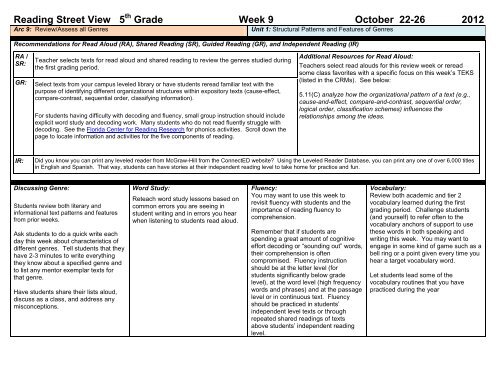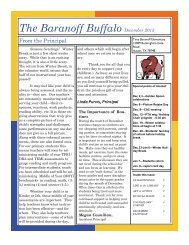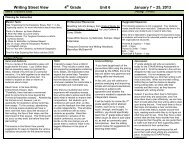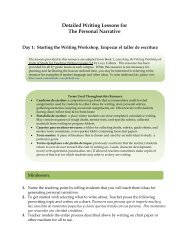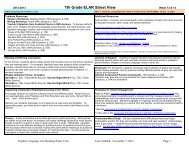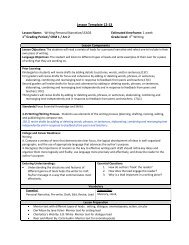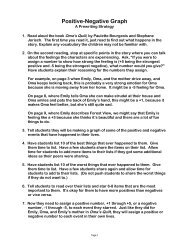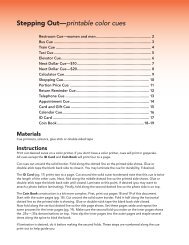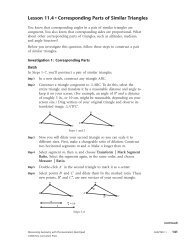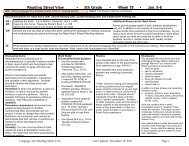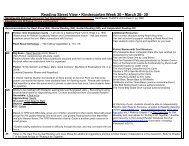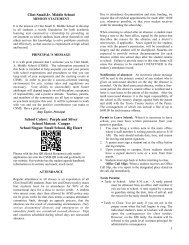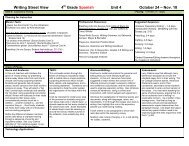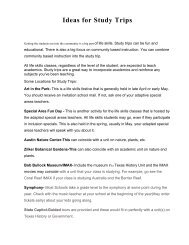Reading Street View 5 Grade Week 9 October 22-26 2012
Reading Street View 5 Grade Week 9 October 22-26 2012
Reading Street View 5 Grade Week 9 October 22-26 2012
- No tags were found...
Create successful ePaper yourself
Turn your PDF publications into a flip-book with our unique Google optimized e-Paper software.
Building Comprehension:Take this week to refer back to literary texts read during the first 9 weeks to allowstudents to make connections about the elements of story, character traits,common problems and themes in stories. Also refer back to informational textsthat were previously read to help students see the differences between thestructures and features of literary and informational texts.Divide students into groups of 3 or 4. Each group draws a slip of paper with thename of a genre studied during the first grading period. Each group plans apresentation for the class to explain the characteristics and features of the genreand present 2-3 mentor texts (and a short written summary of each text).21 st Century Learning:COMMUNICATION AND COLLABORATION: Communicate Clearly- Articulate thoughtsand ideas effectively using oral, written and nonverbal communication skills in a variety offorms and contexts; Listen effectively to decipher meaning, including knowledge, values,attitudes and intentions.Comprehension/ Discussion Questions:Informational:What does the title tell you about the topic?What information is provided through illustrations, photos, captions, and other textfeatures?What do you already know about this topic?What part of the topic has the author chosen to present in the selection?What details support the idea that __? Where in the text can you findinformation/facts/details about __?What questions come to mind about __?What events caused other events to happen in the text?Literary:How does the author begin the story and engage the reader?What is the story problem? How do you think it will be solved?What challenges do the characters encounter? How do they deal with thechallenges?What choices do the characters have?What questions do you have about the character and her choices?How do a character’s actions affect other characters in the story?What are the important events in the story? What caused __(event) to happen?Anchors of Support for Independent Student Work:Review and update or add to anchors of support that were used during thisgrading period. Determine with students which anchors need to stay posted andwhich can be filed in an anchor chart portfolio. As a class, use Inspiration® to discuss making a web about thegenres they have explored. Assign groups of 2-4 students, and haveeach group create a detailed web showing the characteristics of eachgenre.Technology Application 10 Chttp://www.atomiclearning.com/k12/home for teacher tutorialsHave an author’s celebration or an author’s tea and invite students andadults from other classrooms and parent to come hear the writing thestudents have completed during the first grading period.Have students create invitations to the author’s celebration.Teacher Tips: This week involves review and reteach. Use this time to have students go back to lessons in Learning.com® they have missed, or to use software theyhave become familiar with to review reading skills and genres.
<strong>Reading</strong> <strong>Street</strong> <strong>View</strong> 5 th <strong>Grade</strong> <strong>Week</strong> 10 <strong>October</strong> 29 – November 2 <strong>2012</strong>Arc 1: <strong>Reading</strong> Fictional TextsUnit 2: Making a Difference[Theme, Inference, Summary]Recommendations for Read Aloud (RA), Shared <strong>Reading</strong> (SR), Guided <strong>Reading</strong> (GR), and Independent <strong>Reading</strong> (IR)RA /SR:GR:IR:Letters from the Revolution, Treasures Unit 1 p. 98Sleds on the Boston Common, Treasures Unit 1 pgs 101 – 117Approaching Level: The Shot Heard Around the WorldOn Level: The Shot Heard Around the WorldBeyond Level: The Shot Heard Around the WorldELL: The American Revolution BeginsTeacher Tip: Even in 5 th grade we have students who are reading at varying levels. Use your guided reading time tofocus on ways to help individual students. For example, you may need to devote some time to word work if you havea group of students who are struggling with decoding. Fountas and Pinnell say, “<strong>Reading</strong> instruction must bespecific to students’ needs… You base your specific teaching during guided reading on your observations of yourstudents’ reading behavior over time, always thinking about what your students need to know.” They suggest workingfor phrasing and fluency, solving multisyllable words, introducing new genres, learning to read new kinds of texts,and connecting personally with reading as some of the lessons within needs-based grouping.Additional Resources for Read Aloud:Other stories with a “Making a Difference” theme:Mercedes and the Chocolate Pilot by Margot Theis RavenPink and Say by Patricia PolaccoMinty: A Story of Young Harriet Tubman by Alan SchroederChapter Books:Diary of a Young Girl by Anne FrankHoot by Carl HiaasenFrom the National Geographic Reach book provided with the textbook:Message in a Bottle pg. 485Where I Live pg. 501One Hen pg. 576See the AISD website for more books with a "Philanthropy" theme.Students should be writing about what they read in their reader's response journals. The key to success with the reader's response journals is for the teacher to read themregularly and write encouraging comments and good questions for the students. The response journals should evolve into a dialogue between teacher and student about thingsthat the student is reading. Looking for something that students can read at home or at lunch? The Treasures Home School Connections (on CD) has dozens of well-written,short stories that can be copied, folded, stapled and given to the students.Discussing Genre:When studying fiction texts with your studentsduring the first nine weeks, you createdanchor charts which focused on the elementsof fiction and also looked at story arcs to mapthe main events in a story. This weekprovides a good opportunity to review bothstory elements and story arcs. Good readersare able to automatically adjust their thinkingabout both fiction and non-fiction textsdepending on what genre they are reading.Characters play important roles in fiction. In5 th grade, students should learn theprotagonist and antagonist roles. Page 111in the TE gives a good explanation of theseroles and will help you facilitate a discussionwith your students about the text.Students need to hear how good readersthink about a text. Stuck? The TE givesexamples of “Think Alouds” (in blue) for eachtext and also includes possible studentresponses (in red.)Word Study:Resources:Treasures TE 5-Day Spelling Routine and thePhonics/Spelling Practice Book (Treasures CD).Note also that the “Prepare” section of the TEprovides additional suggestions for teaching thePhonics/Word Study patterns.Another Word Study tip:As the Word Wall gets filled up with words,teachers need to hold the studentsaccountable for using this valuable tool.When students do not know how to spell aword or if they misspell a word, ask them,"Is there a word on the word wall that canhelp you?" For example, if the word"thought" is on the word wall, and astudent misspells the word "fought," theteacher could ask the student to use“thought” to help them spell the wordcorrectly.Fluency:Resources:Use the Treasures Approaching Reproducibles,Beyond Reproducibles, and Practice Book(Treasures CD) to select the appropriate fluencypassage for your students. Teach your studentsto help each other determine their fluency rateand answer the comprehension questions.An excerpt from each passage can be found onthe Treasures CD, Fluency Transparencies, forteaching fluency techniques.Another Fluency Tip:Use Community Circle or Morning Messageto teach a short, topical poem to the class.(For example, a Google search for "RespectPoem" reveals dozens of great poemsrelated to respecting yourself and others.)Enlarge the poem for the class, talk aboutvocabulary, symbolism, metaphor, etc. inthe poem, and then challenge students tomemorize that poem. This buildscommunity, teaches a lesson, and buildsfluency at the same time.Vocabulary:Resources:Introduce the vocabulary for each selection usingthe Vocabulary/Comprehension passagepreceding each main selection in the TreasuresTE.See the 5-Day Vocabulary Routine in the pagesfollowing each main selection. The routineincludes student friendly definitions, questions toprompt students’ oral practice with the newwords, and activities for student engagement andpractice with the vocabulary words.Another Vocabulary Tip:Challenge students in your grade level tocollect 100 new vocabulary words in themonth of November. Students will need asystem for organizing their personalcollection of vocabulary words (e.g. avocabulary journal or 3x5 index cards). Atthe end of the month (near Halloween) holda party for students who have collected (andlearned) 100 new words.
Building Comprehension:Many students have a difficult time understanding literary theme. They often think about isolatedevents that take place in a story, but rarely think about the moral lesson or the bigger point that authorsmake when they write. The use of familiar texts as examples of theme will help struggling readers havea better understanding of the meaning of “theme.” For example, after reviewing common stories likeThe Boy Who Cried Wolf, The Ugly Duckling, and The Three Little Pigs, the teacher could ask, "Whichof these is a story about the importance of telling the truth?" As students become more sophisticated,the teacher might place several stories in front of the student and ask, "Which of these stories havesimilar themes?"Good readers are able to extract the most important information from a text and summarize as they go.Story arcs are a useful way to extract information from a narrative text without re-telling the wholestory. This is especially beneficial when teaching students how to summarize narrative texts.Fountas and Pinnell suggest the following ways to help students learn to summarize :Write a summary yourself of a text that students know or have read and ask students toanalyze what makes it a summary.Begin the process with short texts that do not have too many details and are easier tosummarize.Work together to create a group summary, selecting and deleting details.Record a retelling of a text on chart paper and turn it into a summary.Ask students to summarize a text in their response journal and respond to this summary inthe letter you write back.Encourage students to practice summarizing by making book talks to recommend books totheir friends. (Guiding Readers and Writers: <strong>Grade</strong>s 3-6 pg. 362)They also state, “The goal [of summarizing] is larger than passing the test. We want students to beable to abstract the important ideas and carry them forward as tools for thought.”Whatever ways you choose to teach your students summary; provide as much scaffolding as possibleby regularly thinking aloud and modeling what a good summary looks and sounds like.Comprehension/ Discussion Questions:Theme:• What is a theme? What are some examples of themes you might find in stories?• What important themes can you identify in this story?• What other stories have we read that have the same themes?• What is the moral of this story? What lesson does the author want us to learn?Summary:• What has happened so far in this story?• Who can summarize what we’ve learned?• What is the basic plot of this story?• What are the most important things that happened?• How would you retell this story in 3-4 sentences?Inference• What do you think the author is really trying to tell us here?• What does the author want us to think about ______?• What clues has the author given us?• What evidence in the text makes us think ______?• What can you tell about ______?• The reader can tell that ______.• Based on the information in the story, the reader can conclude that _____.21 st Century Learing:COMMUNICATION AND COLLABORATION: Communicate Clearly- Listen effectively to deciphermeaning, including knowledge, values, attitudes and intentions; Collaborate with Others-Exerciseflexibility and willingness to be helpful in making necessary compromises to accomplish a commongoal. As a class, use Inspiration® to discuss making a web about thetheme of “making a difference.” Focusing on the plot and characters fromone of the books (shared whole class), discuss how the in the storyrelates to the concept of making a difference. Assign groups of 2-4 students, andhave each group create a detailed web on the theme.[Advanced students might also complete a similar theme-based web with their ownindep. reading.]Technology Application 10 Chttp://www.atomiclearning.com/k12/home for teacher tutorialsLooking for ways to cultivate community and teach social responsibility in yourclassroom? This website is completely devoted to students and ways that theycan make a difference at school and in their communities:Generation OnAnchors of Support for Independent Student Work:Anchors of Support should: Remind students that all fiction stories have story elements. Provide students with a graphic visual of summary. (e.g. a Story Arc) Provide students with a scaffold in thinking about summary. (e.g.Somebody, Wanted/Needed, But, So, Then and/or a Story Arc) Provide students with a way to use text clues to make inferences (pg. 101in the TE has an example of an tool that students may use as they arereading Sleds on the Boston Common to help organize their thinkingCharacters /about the text)RisingActionClimaxFallingActionResolutStrategy for Narrative Summary:-Somebody (identify the character(s)-Wanted (describe the character’s goal)-But (describe a conflict that hinders thecharacter)-So (describe how the character reacts to theconflict)-Then (describe the resolution of the conflict)*Remember to focus on information that is mostsignificant.Teacher Tips: Many common expressions and sayings are also literary themes. When talking about theme, also teach students some of these common expressions and sayings (e.g.Cheaters never prosper — Crime doesn't pay — Honesty is the best policy — David versus Goliath — Blood is thicker than water — All's fair in love and war — All's well that ends well —A friend in need is a friend indeed — Good triumphs over evil — etc.). These sayings are clichés for a reason — they describe themes that come up very often in literature.
<strong>Reading</strong> <strong>Street</strong> <strong>View</strong> 5 th <strong>Grade</strong> <strong>Week</strong> 11 November 5-9 <strong>2012</strong>Arc 2: <strong>Reading</strong> Informational TextsUnit 2: Making a Difference[Author’s Purpose, Theme, Inference, Summary]Recommendations for Read Aloud (RA), Shared <strong>Reading</strong> (SR), Guided <strong>Reading</strong> (GR), and Independent <strong>Reading</strong> (IR)RA /SR:GR:IR:Honoring Freedom (Treasures Time For Kids, pgs. <strong>22</strong> – 23)Rebuilding Jamestown (Treasures Time For Kids, pgs. 24 – 27)Select texts from your campus leveled library or have students reread familiar text with thepurpose of asking relevant questions, locating facts and details, and in identifying explicit causeand effect relationships among ideas in texts.Teacher Tip: Sticky notes are a teacher’s best friend! As you lead students in reading their guidedreading texts, have pre-planned stopping points and questions. Before reading, have students place asticky note at the predetermined stopping point, use the stem, “Read to find out_____” and have thestudents stop and write their thinking when they get to their sticky. This will give students purpose totheir reading.Additional Resources for Read Aloud:Other stories with a “Making a Difference” theme:Mercedes and the Chocolate Pilot by Margot Theis RavenPink and Say by Patricia PolaccoMinty: A Story of Young Harriet Tubman by Alan SchroederChapter Books:Diary of a Young Girl by Anne FrankHoot by Carl HiaasenFrom the National Geographic Reach book provided with the textbook:Message in a Bottle pg. 485Where I Live pg. 501One Hen pg. 576See the AISD website for more books with a "Philanthropy" theme.Savvy teachers understand the value of conferring with students about what they are reading. Children love it when their teacher takes an interest in what they are reading, and positive, encouragingcomments from the teacher make the students read more often and for longer periods of time. Ask the students what's going on in their story -- what do they like about the book? -- what do they thinkwill happen next? Tell students about other stories or authors that they might also be interested in. Keep a few notes about conferences you have with students so you can keep track of their interestsand also so you can be sure that you talk to all of the students at least once per week. Above all, show keen and wholehearted interest in whatever the student is reading.Discussing Genre:This week students should begin exhibiting aclear understanding of the differences betweenfiction and non-fiction texts.When reading informational texts, good readersautomatically call upon their backgroundknowledge of a subject and add to theirknowledge as they process the text. Theyunderstand that informational texts have avariety of text features to help them seek andfind information.When introducing informational texts, helpstudents to engage their backgroundknowledge before reading. A KWL chart is agreat way to find out what your students knowand what they want to learn about a topic.Students should be able to activate and add totheir knowledge as you continue to focus onboth fiction and non-fiction texts written aboutthe American Revolution. Before askingstudents to share as a class, have students fillout a personal KWL chart in their readingjournal. After sharing whole-group, havestudents go back and add to their personalcharts.Word Study:Treasures TE 5-Day Spelling Routine and thePhonics/Spelling Practice Book (Treasures CD).Note also that the “Prepare” section of the TE providesadditional suggestions for teaching the Phonics/WordStudy patterns.Another Word Study tip:Taken from Words Their Way, pg. 2441. Words and word elements selected for studyshould be generative, which means that,whenever possible, we teach about words in“meaning families.” This highlights the awarenessthat particular patterns of relationships can beextended or generalized to other words.2. The words that we initially select forexploration by our students should be selected onhow obvious their relationship is. For example,we will teach clearly related words such asrepresent/misrepresent before teaching aboutwords that are less clearly related, such asexpose/exposition3. There should be a balance of teacher-directedinstruction with students’ exploration anddiscussion.Fluency:Use the Treasures ApproachingReproducibles, Beyond Reproducibles, andPractice Book (Treasures CD) to select theappropriate fluency passage for yourstudents. Teach your students to help eachother determine their fluency rate and answerthe comprehension questions.An excerpt from each passage can be foundon the Treasures CD, FluencyTransparencies, for teaching fluencytechniques.Another Fluency Tip:Give the students collections of jokesand riddles, and allow them to pick out afew that they can tell to the class onFriday. Have them work in pairs topractice telling their jokes so they candeliver them perfectly when it is theirturn.This can be a regular, recurring featurein your class — every Friday, theteacher calls on a few students to tellthe jokes they've been practicing thatweek.Vocabulary:Resources:Introduce the vocabulary for each selection usingthe Vocabulary/Comprehension passagepreceding each main selection in the TreasuresTE.See the 5-Day Vocabulary Routine in the pagesfollowing each main selection. The routineincludes student friendly definitions, questions toprompt students’ oral practice with the newwords, and activities for student engagement andpractice with the vocabulary words.Another Vocabulary Tip:Encourage students to create their owncollections of words in a notebook or onindex cards. When students encounterinteresting words, they should write themdown for their personal collections. Studentswho collect the most words in a week canbe the "word wizard" on Friday who quizzesthe other students about vocabulary learnedthat week.
Building Comprehension:Features of informational texts include print features, graphic aids, organizational aids, and illustrations.Good readers understand how to use these features to find and build knowledge about a topic. Theimportance of these features lies in the information they provide the reader. Too often we fall into the trapof having our students label the features rather than teaching how to use them as a useful tool for locatinginformation.Students must learn that the summaries of narrative and expository text are different. While narrativesummaries touch upon the important literary elements and events in a story, expository summaries aremuch more formal, including the answers to the “reporter’s questions”: Who, What, When, Where, Why, andsometimes How. This reporting strategy is used to help students understand summarization of nonfictiontext, and can be used both during and after reading.The following link provides an alternative way to write an expository summary:NF Summary – Combining Main Ideas. If you choose to use this graphic organizer, be sure studentsunderstand the difference between main idea and summary.To scaffold creating a non-fiction summary for students, break the text into smaller chunks. Then usegestures or illustrations to convey the meaning of the chunk from the passage. Ask students to orallysummarize the text as you go through, putting the ideas together in a coherent summary.*See <strong>Week</strong> 11 CRM “Performance Tasks” for an example of a way for students to organize their thinkingabout reading. (What I Read, What I Think, What I Saw, How Text Features Helped.)*Don’t underestimate the power of modeling for your students. The more you model good readinghabits, the more your students will take on those behaviors.21 st Century Learning:COMMUNICATION AND COLLABORATION: Communicate Clearly- Listen effectively to deciphermeaning, including knowledge, values, attitudes and intentions; Collaborate with Others-Assume sharedresponsibility for collaborative work, and value the individual contributions made by each team member. Students should continue the practice of analyzing text features and author’spurpose throughout the year. We know, also, that learning how to use a particulartechnological tool is of little benefit if we do not follow the learning with practical application. Review the discussions you’ve had about text features and author’s purpose.Group students in pairs or trios. Each group creates a spreadsheet to use as they read both fiction andnon-fiction selections for the rest of the semester. See sample at this link: Thinking About my<strong>Reading</strong>When the groups finish their spreadsheet, have them save it to the campus share drive (each studentshould share a copy with the title and the student’s name added. This way each child can continue addingto his or her chart as they read throughout the year. Technology Applications: 1B, 7B, 10CLooking for ways to cultivate community and teach social responsibility in yourclassroom? This website is completely devoted to students and ways that they canmake a difference at school and in their communities: Generation OnComprehension/ Discussion Questions:Theme:• What is a theme? What are some examples of themes you might find instories?• What important themes can you identify in this story?• What other stories have we read that have the same themes?• What is the moral of this story? What lesson does the author want us tolearn?Summary:• What has happened so far in this story?• Who can summarize what we’ve learned?• What is the basic plot of this story?• What are the most important things that happened?• How would you retell this story in 3-4 sentences?Inference• What do you think the author is really trying to tell us here?• What does the author want us to think about ______?• What clues has the author given us?• What evidence in the text makes us think ______?• What can you tell about ______?• The reader can tell that ______.• Based on the information in the story, the reader can conclude that _____.Anchors of Support for Independent Student Work:Anchors of support should:• Remind students of terminology used with summarizing.• Help students understand what constitutes a good summary.• Provide students with a graphic visual of a summary (e.g. Who, What, When,Where, and How)• Remind students that summary of narrative text is different than summary ofexpository text.• Make a distinction between explicit information and implied information in text.(What does the author say? What does the author mean?)• Remind students to use evidence from the text to support conclusions aboutthe author’s intended message.LA Inference ORS ModuleStrategy for Expository Summary:-Who/What is the passage mostly about?(topic or subject)-What is important about the topic orsubject?-When does this take place?-Where does this take place?-Why is the topic or subject important?-How does this occur?Teacher Tips: In 5th grade, the TEKS specify that students will be able to evaluate whether the author effectively achieved his or her purpose in writing a passage of text. Studentstherefore need to have a fairly sophisticated understanding of author's purpose for writing. In the past, some teachers taught their students to memorize the mnemonic "PIE" to helpstudents remember author's purpose for writing text (Persuade, Inform, Entertain = PIE.) Today, students need to have a more nuanced understanding of authors and their craft. Authorsoften, for example, write informational text that is also highly entertaining. Historical fiction, for example, is not simply written to inform, and editorials in the newspaper are often bothinformative and persuasive. Students in 5th grade should be able to analyze author's purpose at that level, understanding the multiple objectives an author may be attempting to achievein writing a particular passage of text. They should also consider what they get out of a passage of text, and determine whether the author's goals were met. Was the passage reallyentertaining? Is this the most persuasive argument the author could have written?
Building Comprehension:Explain and discuss the narrator’s point of view in Autobiography and Biography:Explain to your students that the narrator in a story is the person who tells the story. Whenthe narrator uses the words I, me or my to tell a story about something that happened tohim or her, the story is told from the first-person point of view. Ask students to identify thenarrator of an autobiography. Ask students: How do you know who the narrator is? Canyou prove your answer? Show me where in the story you see the use of I, me, or my?What sentences exactly?Point out that a biography of a real person’s life is told by another person and is told from athird-person point of view (he, she, they). (There are different forms of 3 rd person narration;however, students do not need to know these additional forms to understand the differencebetween autobiography and biography.) Have students look at a biography of an authorthey know and compare it with the autobiography. Have them discuss how the biographyand autobiography are alike and different.Tell students that good readers stop and ask themselves questions when they read, suchas: I notice the words, I, me, my in this selection. I wonder what kind of text I’m reading?Use the following questions to support Comprehension of Biographical text:Literary Language and Devices What literary language and devices are used in biographies and autobiographies? How did the author use dialogue, flashbacks, foreshadowing, and other ways oforganizing text to make this person’s life interesting? Are the events depicted for the subject’s life believable and consistent with otherinformation about the time period?21 st Century Learning:CRITICAL THINKING AND PROBLEM SOLVING: Reason Effectively- Use various types ofreasoning (inductive, deductive, etc.) as appropriate to the situation: COMMUNICATION ANDCOLLABORATION:; Collaborate with Others-Assume shared responsibility for collaborative work,and value the individual contributions made by each team member.Comprehension/ Discussion Questions:Point-of-<strong>View</strong> Who is telling the story? How do you know? Where is the author? Does this story tell us the thoughts of all the subjects or characters or just the maincharacter (subject)? What words show you that this selection is an autobiography/biography? Is the author of this story writing about a personal experience? Did _____ write this story from his/her experiences or someone else’sexperiences? How do you know? Is the narrator is this story speaking from personal experiences? How does knowing the author’s point-of-view help the reader understand thestory?Theme:• What is a theme? What are some examples of themes you might find in stories?• What important themes can you identify in this story?• What other stories have we read that have the same themes?• What is the moral of this story? What lesson does the author want us to learn?Biography: How did the author organize the telling of the events of the person’s life(chronological, under topics, etc.)? How did the use dialogue, flashbacks, foreshadowing, and other ways oforganizing text to make this person’s life interesting? What was the author trying to say by writing about this person?Anchors of Support for Independent Student Work:You may want to use Venn Diagrams to compare subjects in biographies or autobiographies.The use of idioms is a great way to make writing more interesting.A fun site of illustrated idioms (drawn by kids):Idioms by KidsSee this site for Ppts, lesson ideas, and games all devoted to idioms:Idiom ResourcesFunBrain has a good game for practicing with idioms:http://www.funbrain.com/idioms/Idiom LessonLooking for ways to cultivate community and teach social responsibility inyour classroom? This website is completely devoted to students andways that they can make a difference at school and in their communities:Generation OnPerspective/Point of <strong>View</strong> Chart:First person point of view: May be the main character telling the story directly; uses I and me.Third person: May be an anonymous outsider who reveals everything about the main and supportingcharacters through actions, dialogue, and thoughts; uses he, she, they.Texts wehave ReadExample of a Literature Chart for the Making a Difference UnitHow did theCharacters/Peoplein the text make adifference?Making a DifferenceWays that Iconnect to thecharacters/people:Ways that I canbe like thecharacters inthe text:How are thesetextsconnected?Teacher Tips: You will notice that in 5 th grade the reading skills have become increasingly intertwined and complex. We expect our students to take on good reader habits of thinkingabout several skills at once while reading. Good readers can do many things at once including: thinking about the point of view of a text while inferring, summarizing what has been read,and identifying the meaning behind figurative language. It becomes our job as teachers to teach in a way that brings all these skills to the forefront. We can raise the skill of point of view(for example) for focus during the week, but we must not forget that our students should be learning how to use all good reader habits as they read. We do this through the use ofmodeling, anchor and literature charts, diagrams, and our pre-planned stopping points with questions that focus on all the skills being taught.
<strong>Reading</strong> <strong>Street</strong> <strong>View</strong> 5 th <strong>Grade</strong> <strong>Week</strong> 13 November 19-20 <strong>2012</strong>Arc 4: <strong>Reading</strong> PoetryUnit 2: Making a Difference[Theme, Structural Elements of Poetry, Analogies]Recommendations for Read Aloud (RA), Shared <strong>Reading</strong> (SR), Guided <strong>Reading</strong> (GR), and Independent <strong>Reading</strong> (IR)RA /SR:GR:IR:Paul Revere’s Ride, Treasures Unit 1, pgs. 120-123The Mother of the Movement, Treasures Read-Aloud Anthology p. 82The Circle and the Pole, Treasures Read-Aloud Anthology, pgs. 101-103Mojave, Treasures Read-Aloud Anthology, p. 73Suspense, Treasures Student Book, Unit 2, p. 236A Symphony of Trees, Treasures Read-Aloud Anthology, pgs. 23-25Use poetry books from your campus that support the focus TEKS for this week.Teacher Tip: Poetry folders that your students can add to all year are a great way to help studentsbuild their fluency. This ensures that all your students have texts that they are able to read. Find poemsthat you think your students will enthusiastically embrace, type them up and add them to their poetryfolders. If you provide your students with opportunities to practice their poems, you will see an increasein fluency, and by the end of the year, your students should have many of the poems memorized.Additional Resources for Read Aloud:All But Blind (Treasures, Anthology p. 108The Circle and the Poles (Treasures Read-Aloud Anthology p. 101)Hot Air Balloon Haiku (Treasures, Unit 2, p. 214) [Haiku]Navajo Code Talkers (Treasures, Unit 3, p. 372) [Cinquains]Home on the Range (Treasures, Unit 5, p. 574) [Song lyrics]Additional books to use for poetry:Where The Sidewalk Ends by ShelSilversteinLove That Dog By Sharon CreechOut of the Dust By Karen HesseI Never Saw Another Butterfly by Hana VolavkovaYo! Yes! by Chris RaschkaSpeak to Me by Karen English and Amy June BatesTo gather information about your students as readers, create a system that allows you to keep notes every time you confer with a student. A recipe card holderwith an index card devoted to each student, a spiral notebook, or another type of organizational tool will help you collect valuable information. These tools will allow you to keep track of short runningrecords, students’ book choices, and the notes you take while students tell you about their books and read to you during your conference. Showing genuine interest in your conversations withstudents about their reading will help keep your students’ spirits high during independent reading time, and keep them looking forward to their one-on-one conferences with you.Discussing Genre:5 th graders may be the oldest students in anelementary school, but they still respond to ritual androutine. In The Art of Teaching <strong>Reading</strong>, Lucy Calkinssays:One important part of building a classroom communityis finding ways to cross the threshold, ways to mark theclassroom as a world apart…In many classrooms, themorning read-aloud convenes the community… Theremay be a song or a choral reading of a familiar poemthat serves as an incantation… We often choose a textthat can act like a lantern, lighting our way…For ouropening read-aloud we select poems and picture booksthat make us all laugh and fall in love with words. Thisread-aloud time tends to last only five minutes or so.We don’t stop to clap out the syllables in compoundwords, preteach vocabulary, or elicit children’spredictions. We simply get out of the way and let thewords work their magic.This week, let the words of the poems that you choosework their magic on your students. Allow them toexperience the language and rhythm of poetry. Tryusing a poem or song as a transition from oneclassroom routine to the next. It might just add a newspark to daily interactions with your students!Word StudyResources:Treasures TE 5-Day Spelling Routine andthe Phonics/Spelling Practice Book(Treasures CD).Note also that the “Prepare” section of theTE provides additional suggestions forteaching the Phonics/Word Studypatterns.Another Word Study tip:The following is a description of how tofacilitate older students’ collections ofinteresting words: (See Words Their Way,pg. 246 for additional information.)1. Collect the word.2. Record the word and sentence.3. Look at word parts and thinkabout their meaning.4. Record related words.5. Use the dictionary (cautiously).6. Review the words.Fluency:Resources:Use the Treasures Approaching Reproducibles,Beyond Reproducibles, and Practice Book(Treasures CD) to select the appropriate fluencypassage for your students. Teach your studentsto help each other determine their fluency rateand answer the comprehension questions.An excerpt from each passage can be found onthe Treasures CD, Fluency Transparencies, forteaching fluency techniques.Another Fluency Tip:Model reading poetry aloud with fluency.Read the poem, The Mother of theMovement (Treasures TE, p. 7A) and askthe students to focus on your rate andexpression as you read. Slow down insections of the poem to add drama to yourreading, and add expression and emotion toemphasize the mood of the poem.Have students practice repeatedly readingpoems like The Mother of the Movementwith the same fluency and expression thatyou modeled.Vocabulary:Resources:Introduce the vocabulary for each selection usingthe Vocabulary/Comprehension passagepreceding each main selection in the TreasuresTE.See the 5-Day Vocabulary Routine in the pagesfollowing each main selection. The routineincludes student friendly definitions, questions toprompt students’ oral practice with the newwords, and activities for student engagement andpractice with the vocabulary words.Another Vocabulary Tip:Play the synonym game with your students.Divide the class into two teams. With each round,the teacher introduces a word with manysynonyms (e.g. "happy"), and each team mustcome up with as many synonyms as they can in 3minutes (e.g. glad, cheerful, delighted, elated,etc.). The teacher keeps score, awarding 1 pointfor each word a team thought of that the otherteam did not think of. (e.g., If both teams think of"thrilled," then neither team gets a point, but ifonly one team thinks of that word, they get a pointfor it.) Don't forget to encourage students to usewords from the word banks in the classroom.
Building Comprehension:For an additional poetry lesson and definitions of the Elements of Poetry, see thiswebsite: Elements of PoetryThe end of the “Making a Difference” unit provides the perfect chance to help cultivate ourstudents’ natural compassion and understanding. This two-day week provides the perfectopportunity to celebrate ways that students can make a difference in their everyday lives, orwith others, and also connect to the characters in the books that they have been reading.If you have not done so yet, this is a good week to adopt a “project” with your class. Needideas for school or community based projects? Generation On provides lists of ideas for howstudents can make a difference for others, many of which can be done right at school! Theirmission is “To inspire, equip, and mobilize youth to take action that changes the world andthemselves through service.” What better way to build community within your classroom andfoster a sense of social responsibility in your students?21 st Century Learning:CRITICAL THINKING AND PROBLEM SOLVING: Use Systems Thinking- Analyze how parts of awhole interact with each other to produce overall outcomes in complex systems: COMMUNICATION ANDCOLLABORATION:; Collaborate with Others- Articulate thoughts and ideas effectively using oral,written and nonverbal communication skills in a variety of forms and contexts; Listen effectively to deciphermeaning, including knowledge, values, attitudes and intentions; LEADERSHIP AND RESPONSIBILITY:Be Responsible to Others- Act responsibly with the interests of the larger community in mind.Comprehension/ Discussion Questions:Poetry:• What does the poem say to you?• How did the poem make you feel?• What did the poem make you think about?• What did you notice?• Were there any words or phrases you especially liked?• Does the poem remind you of anything in your life?• What do you think the poet was thinking?• Who’s talking in the poem?• What did you notice about the way the author wrote the poem?Theme:• What is a theme? What are some examples of themes you might find in stories?• What important themes can you identify in this story?• What other stories have we read that have the same themes?• What is the moral of this story? What lesson does the author want us to learn?Anchors of Support for Independent Student Work:This chart is just an example of a chart that you can use to help students connect to the unittheme and understand the texts. Feel free to change or add to the guiding questions.Students should complete the chart this week and present to the class individually or ingroups.Making a DifferenceAllow students to work in pairs or groups to come up with a presentation for the classcentered on ways that they can make a difference in their everyday lives. Have studentsconnect their presentations to the characters/people that they have been reading about. Whattraits do the students share with the characters?Ideas can include working in pairs to create a PowerPoint to share with the class and/or school,and/or creating a class book titled, “Our Class can Make a Difference.”Allow every group to make their own slide or write a page for the book about how they like tomake a difference.Texts wehave ReadHow did theCharacters/PeopleMake a Difference?Ways that I connectto the characters/people:Ways that I canbe like thecharacters inthe text:How are stories fromother places andtimes about me?Useful poetry websites:http://learn.lexiconic.net/elementsofpoetry.htmA focus this week is on analogies. For more information, go to this website:http://www.spellingcity.com/analogies.htmlThis website contains a list of ways that people can make a difference every day. Goodconversation starters to use with your students:25 Ways to Make a DifferenceTeacher Tips: In The Understanding by Design Guide to Creating High-Quality Units, Wiggins and McTighe state that,“Individuals who can understand and transfer their learning – have perspective: see the big picture; are aware of, and consider, various points of view; take a critical or disinterested stance;recognize and avoid bias in how positions are stated.--- have empathy: perceive sensitively; can “walk in another’s shoes”; find potential value in what others might find odd, alien, orimplausible.” As this is the end of the “Making a Difference” unit, take a moment to assess your students. Which of your students are able to transfer their understanding as it relates to thetext through perspective and empathy? Good readers are able to read with perspective and empathy along with a myriad of other skills. Are you students progressing in these areas? Whatare some mini-lessons that might be conducted around these skills at the beginning of the next unit in order to strengthen your students understanding?
<strong>Reading</strong> <strong>Street</strong> <strong>View</strong> 5 th <strong>Grade</strong> <strong>Week</strong> 14 *MOY WEEK* November <strong>26</strong>-30 <strong>2012</strong>Arc 5:Unit 3: Connecting Texts (Nature)Recommendations for Read Aloud (RA), Shared <strong>Reading</strong> (SR), Guided <strong>Reading</strong> (GR), and Independent <strong>Reading</strong> (IR)RA /SR:GR:IR:Use this week to revisit any fiction or non-fiction text selections and re-read to strengthenvocabulary and content knowledge.Students have been reading many texts since the beginning of the year in both their guided readinggroups and during their independent reading time. Use this week to have students write reviews forsome of their favorite books and present them to the class.In, The Art of Teaching <strong>Reading</strong>, Lucy Calkins says:Of course, when we go to the library or the bookstore, our selections are guided by the reviews we haveread or heard. Children are less apt to have other people’s reviews in mind when they look over acollection of books. One way teachers can provide some of this supportive context for book choice is toencourage children to share their opinions about books they’ve read… Promotional book talks are aformal means of supporting what happens informally all the time. Books take on social currency. Theyare the talk of the town. Children tell each other, “You gotta read my book. It’s so cool.”Additional Resources for Read Aloud:Other stories with a “Nature” theme:The Lorax by Dr. SeussThe Great Kapok Tree by Lynne CherryA River Ran Wild by Lynne CherryChapter Books:Hoot by Carl HiaasenFrom National Geographic Reach:Energy for the Future pg. 118 (Nonfiction)Coyote and Badger pg. 158 (Realistic Fiction)Living Links pg. 117 (Expository Nonfiction)Fish of the Future pg. 190 (Nonfiction)Phyto-Power! Pg. 209 (Nonfiction)One Well pg. 306The World of Waste pg. 465As adult readers, most of us probably have a running list of books that we want to read. We participate in book clubs or book chats, and we tend to perk up and pay attentionwhen we hear someone else talk about their favorite books. Children who are developing their skills and interest in reading are really no different. Teachers should encouragestudents to have book talks where they share with the class what they have been reading and why they think that other students should read it, keep lists on the wall wherestudents can recommend books to each other, and a list in their journal where they keep “Books to Read.”Discussing Genre:A primary focus this year is on teachingour students how to move seamlesslyfrom one genre to another in theirreading. The MOY week offers aperfect opportunity to revisit/reviewgenres that you feel your students needmore exposure to. Are studentsgrasping and able to verbalize thedifferences between genres? Arestudents able to adjust the ways theyread the various genres?Word Study:Resources:Treasures TE 5-Day Spelling Routine and thePhonics/Spelling Practice Book (Treasures CD).Note also that the “Prepare” section of the TEprovides additional suggestions for teaching thePhonics/Word Study patterns.No Additional Word Study Tip for thisweek.Fluency:Resources:Use the Treasures Approaching Reproducibles, BeyondReproducibles, and Practice Book (Treasures CD) toselect the appropriate fluency passage for yourstudents. Teach your students to help each otherdetermine their fluency rate and answer thecomprehension questions.An excerpt from each passage can be found on theTreasures CD, Fluency Transparencies, for teachingfluency techniques.Another Fluency Tip:Silly Poems. Teach the students that poetry canbe serious and sophisticated, but it can also befun and silly.Select poems from resources likewww.gigglepoetry.com that the students canpractice and read aloud for the whole class. Justlike with jokes, the presentation of the poem ishalf of the humor, so give students time topractice with a partner so they can present thepoem with fluency and style.Vocabulary:Resources:Introduce the vocabulary for eachselection using theVocabulary/Comprehension passagepreceding each main selection in theTreasures TE.See the 5-Day Vocabulary Routine inthe pages following each mainselection. The routine includesstudent friendly definitions, questionsto prompt students’ oral practice withthe new words, and activities forstudent engagement and practice withthe vocabulary words.
Building Comprehension:Conferring with our students about their independent reading provides an opportunity forimmediate feedback. In The Art of Teaching <strong>Reading</strong>, Lucy Calkins calls the type ofconferences that she holds with her readers and writers the Research-Decide-Teachconference.[Conferring with young readers (as with young writers) first involves research in order tolearn where the child is as a reader and understand the child’s intention, then decidingwhat we should teach, and then teaching in a way that can influence what that child doeson another day with another book.]This is a perfect week to catch-up on reading conferences with your students; then visit andset reading goals. Use the following information to help guide your conferences and setgoals for your students.Many of our fifth grade students are reading chapter books. Calkins suggests looking forthe following “clues” about how a child is reading [this is part of the research and decidephase]:Is the reader:Figuring out who is talking, especially if the text doesn’t regularly spell this out bysaying, for example, “said Bill”?Dealing with sections of the text that contain more exposition? These tend to be inlarge, chunky paragraphs, which are harder to read than the more airy sections ofdialogue.Keeping the characters straight, especially if there are many?Following the plot, especially if there are many?Determining who is the narrator of the story?Pointing at the text or subvocalizing [moving lips while reading] (in which case Imay want to tell them it is time for them to graduate from using these strategies)?Recalling the earlier chapters as he or she reads a later one? Can the readeraccumulate the text?Other “clues” that you may look for when conferring with your students:Is the reader:<strong>Reading</strong> a variety of genres? (Take a quick look at their reading log.)Making inferences?Adding to the schema/background knowledge that he/she has about a particularsubject?Transferring new learning from mini-lessons to independent use?*This is only a sample of strategies that readers use and not a complete list.*21 st Century Learning:PRODUCTIVITY AND ACCOUNTABILITY: Manage Projects- Set and meet goals, even in the face ofobstacles and competing pressures. For additional information on independent reading conference includingprompts and organizers for reading response journals, additionalassessment tools, and reading strategies, see this website:E-Workshop Independent <strong>Reading</strong> Module The following pages are particularly useful:o Sample <strong>Reading</strong> Strategies – pg. 6o Guidelines for Assessing a Student’s Comprehension – pg. 12o How to Use Written Responses – pg. 20(Continued from previous column)After researching how the student is reading and deciding what he/she needs instructionon, Calkins moves into the teaching portion of the conference:I begin my conferences with “the connection,” in which I tell the child what I want to talkabout, why it seems important, and how it fits into the things we’ve been doing together.Next I teach. I give information. I offer a bit of advice. I demonstrate what I hope the childwill do. I suggest a strategy other readers use. It is tempting to end the conference here…Instead, I often try to get the reader to start using the new strategy right then and there, andI coach the reader toward this.<strong>Reading</strong> goals provide good information for teachers, students, and parents. If goals aresent home, parents can also help the students work towards meeting them. Goals alsoprovide a structure for future conferences and give students purpose during theirindependent reading time.Calkins gives the following examples of goals that students set during conferences withtheir teachers: Give myself a retelling test often so I make sure I’m understanding the book. UsePost-its to mark the major new parts of the story. Reread last year’s read-alouds and try to see things I didn’t see before, and thatway try to be a deeper reader. I want to read to know more stuff (like learning about cell structure, because I thinkit’s cool). I am trying to read so I do something. First I’ll read a chess book so I can beready for a tournament. I am trying to find the “big stuff” in books, not just what happens. I am trying to talk about my books and grow intellectually.The examples provided above are ones that students set for themselves, however, bothstudents AND teachers should have an active role in setting goals. Goals that will help thereader strengthen his/her reading habits and to push the reader to choose different genresof books should be set during conferences.Calkins also says:Some teachers find that if they want conferences to have a lasting effect on a reader,one conference should set the direction for future ones. It helps to expect that particularconferences will yield “personal goals” and that other conferences will address the reader’sprogress toward these goals.Whatever goals you set, it is a good idea for both you and your students to keep a record ofthem for future reference.Teacher Tips for the MOY week:Towards the end of the week, you might find it useful to review the <strong>Reading</strong> MOY tests withyour students. This helps to create an air of transparency within your classroom –celebrating the skills that were mastered, but also focusing on skills that need morepractice. What skills did individual students show mastery? What skills are individual students still struggling with? What skills did the class as a whole show mastery? What skills is the class as a whole still struggling with? How does this help to inform future lessons? Independent reading conferences?
<strong>Reading</strong> <strong>Street</strong> <strong>View</strong> 5 th <strong>Grade</strong> <strong>Week</strong> 15 December 3-7 <strong>2012</strong>Arc 1: Fiction/Non-FictionUnit 3: Connecting Texts (Nature)[Making Connections Between Texts, Dictionary Use, Inference, Summary]Recommendations for Read Aloud (RA), Shared <strong>Reading</strong> (SR), Guided <strong>Reading</strong> (GR), and Independent <strong>Reading</strong> (IR)RA /SR:GR:IR:Juanita and the Cornstalk, Treasures Unit 6, pg. 728Weslandia, Treasures Unit 6, pgs. 731-744Blue Potatoes and Square Watermelons, Treasures Unit 6, pgs. 746-747Approaching Level: Food FightOn Level: Fruit from SpaceBeyond Level: Land of the PeppertoesELL: Space FruitTeacher Tip: Fountas and Pinnell give this tip for guided reading:Avoid “round robin” reading in which everyone takes turns reading aloud. This awkward process –agonizing for both the highly capable students who must wait for their slower peers and the lessexperienced students who are embarrassed to read in front of their peers – slows down instruction andgives grouping a bad name. Instead, make sure that each student reads the whole text or a unified partof the text silently and independently.Additional Resources for Read Aloud:Other stories with a “Nature” theme:The Lorax by Dr. SeussThe Great Kapok Tree by Lynne CherryA River Ran Wild by Lynne CherryChapter Books:Hoot by Carl HiaasenFrom National Geographic Reach:Energy for the Future pg. 118 (Nonfiction)Coyote and Badger pg. 158 (Realistic Fiction)Living Links pg. 117 (Expository Nonfiction)Fish of the Future pg. 190 (Nonfiction)Phyto-Power! Pg. 209 (Nonfiction)One Well pg. 306The World of Waste pg. 465While conferring with your students you should watch the notes that students are making as they are reading. Are your students relying heavily on one particular strategy ratherthan using all strategies as they read? If you observe that students are leaning on one reading strategy rather than utilizing all, it would be a good time to do a whole classminilesson on how good readers have many in-the-head strategies that they use as they read. For example, one lesson might be how good readers ask questions as they read,but then search and find the answers.Discussing Genre:For the past 14 weeks, you have beenreading texts in a variety of genres.Chances are, you have already beenable to talk to your students about theconnections that they are noticingacross texts. The connections mighthave been through a theme such as“Making a Difference” or throughcontent such as the AmericanRevolution. This week, have studentsmake a Venn Diagram or a T-chart inorder to compare their guided readingbook with another book that they haveread. Are students making surface levelcomparisons, or are they getting to thedeeper meanings in the text? Use theComprehension/Discussion Questionsduring guided reading as well as yourwhole-group lessons.Word Study:Resources: Treasures TE 5-Day Spelling Routine and thePhonics/Spelling Practice Book (Treasures CD). Note also that the “Prepare” section of the TEprovides additional suggestions for teaching thePhonics/Word Study patterns.Another Word Study tip:(Taken from Words Their Way, pg. 248)Word Tree: Words that Grow from Base Words andRoots1. Decide on a base word or a wordroot to highlight.2. Write the base word or rootword at the bottom of the tree, andthink of as many forms as possible.3. Write the different forms onindividual branches.4. Display and encourage studentsto think of, find, and record morederived words.Fluency:Resources:Use the Treasures Approaching Reproducibles,Beyond Reproducibles, and Practice Book(Treasures CD) to select the appropriate fluencypassage for your students. Teach your studentsto help each other determine their fluency rateand answer the comprehension questions.An excerpt from each passage can be found onthe Treasures CD, Fluency Transparencies, forteaching fluency techniques.Another Fluency Tip:5th grade students are not too old to enjoyfeeling like a helper. Pair your class with akindergarten or first grade class and become“Book Buddies.” Allow your students a littletime during their independent reading blockto practice reading the texts that they willshare with their buddies.Vocabulary:Resources:Introduce the vocabulary for each selectionusing the Vocabulary/Comprehensionpassage preceding each main selection inthe Treasures TE.See the 5-Day Vocabulary Routine in thepages following each main selection.Another Vocabulary Tip:1. Definition - provided in theTreasures TEs2. Elaboration - the words are given inmultiple examples or scenarios.3. Repetition- students are hearingand practicing these words over theweek.4. Active Use- Using the words ineveryday discussion and writing!What part of your vocabulary routineneeds more attention?
Building ComprehensionIt is important for students to be able to compare and contrast two text selections (Fiction/Fiction,Fiction/Non-fiction, and Non-fiction/Non-fiction). You can help students understand the concept ofcomparing and contrasting by making analogies to synonyms and antonyms - how things are alike and howthey are different.Fountas and Pinnell say, “Students are often expected to respond to a series of questions that requirereading several different texts, sometimes of different genres. Because your students are reading manydifferent texts in guided reading, literature study and independent reading, you can easily guide them tocompare and contrast those texts. They can compare characters’ appearance, actions, motives, points ofview, and so forth; plots or events; and settings. They can compare fiction, nonfiction and poetic texts onthe same topic or with the same setting (geographical or historical). Comparing texts helps them delve intothe deeper meaning of complex concepts such as “heroism” or “voyages.”Students must learn to use dictionaries to find words and their definitions. The best way to teach dictionaryskills is to authentically model for your students how YOU would use the dictionary. Know the meaning of aword? Pretend that you are stuck. Ask a student to get a dictionary for you. Use your document camera toshow students how you would find the word and its meaning. Use “thinking aloud” to point out howdictionaries provide us with pronunciation, parts of speech and syllabication.Often, definitions contain words that your students might not understand. Provide students with manyexamples of how to read around words and use context to find meaning. Process of elimination is alsohelpful when finding the correct definition for a multiple-meaning word.Want to encourage your students to use their creativity and use different words in place of common ones(such as mad, happy, and sad)? Teach your students how to use a thesaurus to find word replacements.Reward points to students who begin to use the “creative” words in their daily conversations.*We strongly caution against asking students to copy words and their definitions.* Again, theemphasis is on modeling how to authentically use a dictionary and/or thesaurus. When planning for thisweek, keep in mind how you use dictionaries in your everyday life. How can you transfer that knowledge toyour students?21 st Century Learing: CRITICAL THINKING AND PROBLEM SOLVING: Use Systems Thinking-Analyze how parts of a whole interact with each other to produce overall outcomes in complex systems:COMMUNICATION AND COLLABORATION:; Collaborate with Others- Articulate thoughts and ideaseffectively using oral, written and nonverbal communication skills in a variety of forms and contexts; Listeneffectively to decipher meaning, including knowledge, values, attitudes and intentions. Teaching your students dictionary skills is a wonderful way for students to work in partners orgroups. Provide groups of students with a list of sentences that use multiple meaning words and adictionary. Have students find the definition that best matches how the word was used in thesentence. Each group should have different sentences. Groups or partners should present their“findings” to the class and be able to explain why the chosen definition was the best. For PowerPoint presentations to introduce multiple-meaning words, lesson ideas, andgames on multiple-meaning words and dictionary use, see this website: Multiple Meaning WordActivities For creative lesson ideas on dictionary use, see this website: Dictionary Skills We particularly like the “Dictionary Treasure Hunt” and “Stump the Teacher” sections for ways tomake learning dictionary skills fun. Assign www.learning.com lesson, “Creating a Portfolio.” Students will create a portfoliofor saving documents for the rest of the year. {In campus S Drive}Technology Applications: Communication and Collaboration: Students use digital media andenvironments to communicate and work collaboratively, including at a distance, to support individuallearning and contribute to the learning of others; Technology Operations and Concepts: Studentsdemonstrate a sound understanding of technology concepts, systems, and operations: a. understand anduse technology systems; b. select and use applications effectively and productively.Comprehension/ Discussion Questions:Connecting Across Texts:·What is a major idea found in both selections/stories?·The story and the article both present ideas about _____·Why was __ mentioned in both the (newspaper article) and the (story with the journal)?·What is the theme in both selections?·What do the lessons in __ and __ have in common?·What is a common theme in both of the stories?·In comparing __ and __, what was the difference in the moral lessons in the twoselections?·A theme found in both stories is __.Strategy for Narrative Summary:-Somebody (identify the character(s)-Wanted (describe the character’s goal)-But (describe a conflict that hinders thecharacter)-So (describe how the character reacts tothe conflict)-Then (describe the resolution of the conflict)*Remember to focus on information that ismost significant.Anchors of Support for Independent Student Work:Anchors of Support and Graphic Organizers for Connecting Across Texts should: Highlight key terms Provide a visual example of the process of comparingand contrasting texts Include question stems related to comparing andcontrasting ideas in textsSee ORS Module on Connecting Across TextsBoth T-Charts, I-Charts and Venn Diagrams work well to compare texts.Text 1 Text 2Text 1: Text 2:Connections:Strategy for Expository Summary:-Who/What is the passage mostly about?(topic or subject)-What is important about the topic orsubject?-When does this take place?-Where does this take place?-Why is the topic or subject important?-How does this occur?Teacher Tips: Developing comparing and contrasting skills should not be limited to reading! Students can integrate these skills throughout their learning, comparing historical events, animal groups andadaptations, planets, important people, systems of the body, types of clouds, etc. Comparing and contrasting should become a habit of mind for all students
<strong>Reading</strong> <strong>Street</strong> <strong>View</strong> 5 th <strong>Grade</strong> <strong>Week</strong> 16 December 10-14 <strong>2012</strong>Arc 2: Fiction/Non-FictionUnit 3: Connecting Texts (Nature)[Making Connections, Word Meaning – Roots/Affixes, Inference, Summary]Recommendations for Read Aloud (RA), Shared <strong>Reading</strong> (SR), Guided <strong>Reading</strong> (GR), and Independent <strong>Reading</strong> (IR)RA /SR:GR:IR:Dr. Priscilla C. Grew, Geologist, Treasures Unit 2, p. 138Hidden Worlds: Looking Through a Scientist’s Microscope, Treas. Unit 2, pgs.141– 152The Termite, Treasures Unit 2, pg. 154Approaching Level: Searching for CuresOn Level: Searching for CuresBeyond Level: Searching for CuresELL: Science Finds CuresTeacher Tip: The theme of a story is often a difficult concept for students to grasp. As you leadstudents during guided reading, ask students to keep track of what they think the “deeper meaning” ortheme of the text might be. What does the author of the story seem to think is important? How doesthe guided reading text connect to the texts used for whole-group this week?Additional Resources for Read Aloud:Other stories with a “Nature” theme:The Lorax by Dr. SeussThe Great Kapok Tree by Lynne CherryA River Ran Wild by Lynne CherryChapter Books:Hoot by Carl HiaasenFrom National Geographic Reach:Energy for the Future pg. 118 (Nonfiction)Coyote and Badger pg. 158 (Realistic Fiction)Living Links pg. 117 (Expository Nonfiction)Fish of the Future pg. 190 (Nonfiction)Phyto-Power! Pg. 209 (Nonfiction)One Well pg. 306The World of Waste pg. 465Provide a variety of fiction and nonfiction texts on different topics and levels for students to read during independent reading. For nonfiction: Model how to usetwo column notes to record important information in texts (main ideas) in the left column and details in the right. For fiction: Model how to use two column notesto connect to the text: What I read/What it made me think about.Discussing Genre:To infer in both fiction and nonfictiontexts, readers: understand what is not stated but isimplied in the text (both print andillustrations). make conclusions that are not statedbut are based on information found inthe text or illustrations. make judgments about events ortheme that have not been explicitlystated. think about the deeper meanings oftext. use background knowledge andinformation from the text to formtheories about the significance offacts or events.Word Study:Resources:Treasures TE 5-Day Spelling Routine and thePhonics/Spelling Practice Book (Treasures CD).Note also that the “Prepare” section of the TE providesadditional suggestions for teaching the Phonics/Word Studypatterns.Another Word Study tip:(Taken from Words Their Way, pg. 248)Word Tree: Words that Grow from Base Words andRoots1. Decide on a base word or a wordroot to highlight.2. Write the base word or rootword at the bottom of the tree, andthink of as many forms as possible.3. Write the different forms onindividual branches.4. Display and encourage studentsto think of, find, and record morederived words.Fluency:Use the Treasures ApproachingReproducibles, Beyond Reproducibles,and Practice Book (Treasures CD) toselect the appropriate fluency passage foryour students. Teach your students tohelp each other determine their fluencyrate and answer the comprehensionquestions.An excerpt from each passage can befound on the Treasures CD, FluencyTransparencies, for teaching fluencytechniques.Another Fluency Tip:Read a speech with great expression:Speeches are meant to be read withgood timing, phrasing, and intonation.How effective would the GettysburgAddress have been if Lincoln wasmumbling and stumbling over thewords?Vocabulary:Introduce the vocabulary for each selection usingthe Vocabulary/Comprehension passage precedingeach main selection in the Treasures TE.See the 5-Day Vocabulary Routine in the pagesfollowing each main selection. The routineincludes student friendly definitions, questions toprompt students’ oral practice with the new words,and activities for student engagement and practicewith the vocabulary words.Another Vocabulary Tip:Break the class into teams of 4 to 6 studentsand challenge them to find as many words asthey can that are derived a specific root suchas inter (between), geo (earth), dict (speak),and cycl (round). Be sure to pick roots thatare in words that 5th grade students are likelyto know. For example, derm means skin, butmost 5th graders don't know words likedermatology, taxidermy, or hypodermic.
Building Comprehension:Whether it is connecting to the movies that we watch, connecting to others, or connecting to the texts that weread, making connections is a natural process that comes easily to most of us. In teaching, the challenge liesin making our thinking explicit when we make connections, and teaching our students how to identify whenthey are making those connections.In their book, Strategies that Work, Stephanie Harvey and Anne Goudvis state: Generally, kidsstart by making text-to-text connections to more obvious elements of stories, such as characters orproblems. Some text-to-text connections, in order of increasing sophistication, might include:o Comparing characters, their personalities, and actionso Comparing story events and plot lineso Comparing lessons, themes, or messages in storieso Comparing themes, ideas, issues in fiction/nonfiction text pairso Finding common themes, writing style, or perspectives in the work of a single authoro Comparing the treatment of common themes by different authorso Comparing different versions of familiar storiesStrategy for Narrative Summary:-Somebody (identify the character(s)-Wanted (describe the character’s goal)-But (describe a conflict that hinders thecharacter)-So (describe how the character reacts to theconflict)-Then (describe the resolution of the conflict)*Remember to focus on information that is mostsignificant.Strategy for Expository Summary:-Who/What is the passage mostly about?(topic or subject)-What is important about the topic orsubject?-When does this take place?-Where does this take place?-Why is the topic or subject important?-How does this occur?21 st Century Learning:CRITICAL THINKING AND PROBLEM SOLVING: Use Systems Thinking- Analyze how parts of a wholeinteract with each other to produce overall outcomes in complex systems: COMMUNICATION ANDCOLLABORATION:; Collaborate with Others- Articulate thoughts and ideas effectively using oral, writtenand nonverbal communication skills in a variety of forms and contexts; Listen effectively to deciphermeaning, including knowledge, values, attitudes and intentions; ICT (Information, Communications andTechnology) LITERACY: Apply Technology Effectively- Use technology as a tool to research, organize,evaluate and communicate information.Comprehension/ Discussion Questions:Connecting Across Texts:·What is a major idea found in both selections/stories?·The story and the article both present ideas about _____·Why was __ mentioned in both the (newspaper article) and the (story with thejournal)?·What is the theme in both selections?·What do the lessons in __ and __ have in common?·What is a common theme in both of the stories?·In comparing __ and __, what was the difference in the moral lessons in the twoselections?·A theme found in both stories is __.Word Meaning: Do you recognize any part of this word? Is there a prefix or a suffix that helps you figure out what it might mean? Are there parts of this word that are similar to other words you know? A synonym/antonym for ________ is ________. The word ___________ means ____________. The word ___________ is related to ____________.Anchors of Support for Independent Student Work:Anchors of Support and Graphic Organizers for Connecting Across Texts should: Highlight key terms Provide a visual example of the process of comparingand contrasting texts Include question stems related to comparing andcontrasting ideas in textsA “topic quick- write” is a tool you can use prior to reading that will make a difference in thecomprehension of a text. Prior to reading about a topic, students can list the related words andterms they know, write a paragraph discussing what they know about the topic, or simply makenotes about it. These actions help them activate and summarize their knowledge, and anticipatewhat they will read about. After reading, they can go back and add to this information, crossing outideas that are not correct or do not apply to the topic, and writing another paragraph that reflectsthe integration of their existing and new knowledge. Using technology to do quick-writes, andcreate graphic organizers to illustrate their thinking, will help prepare our students for success inthe new global economy.Scientists are devoting more and more time to finding resources to provide for an expanding globalpopulation. You and your students are in a middle of a unit centered on the theme of Nature. Partof (our students) becoming prepared for success in the 21 st Century is to be aware of issues facingour planet. This is a perfect time to read and study cross-content texts about issues impacting ourenvironment. These could include topics such as population development, resource consumptionrate, etc.Have students work with partners, or in groups, to create and design solutions based on theirreading. Students should prepare a presentation for the class to share their findings and solutions.This may be a multi-week project which culminates in presentations the week before Winter Break.See ORS Module on Connecting Across TextsBoth T-Charts, I-Charts and Venn Diagrams work well to compare texts.Text 1 Text 2Text 1: Text 2:Connections:Teacher Tips: By 5th grade, students should understand that vocabulary context clues take different forms, and students should be able to identify the type of context clue used whenexamining an unfamiliar word. For example, a student should be able to tell that the context support is a definition, a synonym, an antonym, an example, a restatement, etc. (See thisSlideshow for Words in Context.). Students should also be able to identify signal words that help them to determine what kind of context support is available (e.g., the words "such as"help the reader understand that an example will be provided.)
<strong>Reading</strong> <strong>Street</strong> <strong>View</strong> 5 th <strong>Grade</strong> <strong>Week</strong> 17 December 17-20 <strong>2012</strong>Arc 3: PoetryUnit 3: Connecting Texts (Nature)[Making Connections, Inference, Theme]Recommendations for Read Aloud (RA), Shared <strong>Reading</strong> (SR), Guided <strong>Reading</strong> (GR), and Independent <strong>Reading</strong> (IR)RA /SR:GR:IR:Choose a variety of poems for students to explore.This site has poems with a wide range ofreadability/complexity:Poems about natureContinue to select leveled books and high interest chapterbooks from your school’s Literacy Library for guided reading.After the lesson, take a moment to note observations, reflect,and take anecdotal records about specific students and theirreading behaviors in order to plan mini-lessons and smallgroup word study.Additional Resources for Read Aloud:Recommended poets whose works are available online include:Roald DahlRobert FrostWilliam BlakeShel SilversteinEmily DickinsonLA Poetry Study ModuleOther stories with a “Nature” theme:The Lorax by Dr. SeussThe Great Kapok Tree by Lynne CherryA River Ran Wild by Lynne CherryChapter Books:Hoot by Carl HiaasenFrom the National Geographic Reach book:Energy for the Future pg. 118 (Nonfiction)Coyote and Badger pg. 158 (Realistic Fiction)Living Links pg. 117 (Expository Nonfiction)Fish of the Future pg. 190 (Nonfiction)Phyto-Power! Pg. 209 (Nonfiction)One Well pg. 306The World of Waste pg. 465Share your love of reading with your students by doing a book talk on a book (or poem) you’re currently reading, discussing your thoughts, feelings, and connections to the book.Discussing Genre:Poetry comes in many forms. Traditional poemsand rhymes, sometimes called nursery rhymes,are many children’s first introduction to poetry.Free verse is poetry that doesn’t rhyme. Lyricpoetry expresses direct, personal emotion in amusical or melodic manner. Narrative poetrytells a story. Limericks are one type ofhumorous poetry with five lines. Lines one, two,and five having three anapestic feet, lines threeand four have two anapestic feet, in the rhymescheme aabba.Writing poetry involves the use of imagery.Authors utilize sensory language to help thereaders create images and feelings in responseto their writing. Sensory language is when theauthor uses words and details that appeal to thereader’s senses (sight, sound, taste, touch,smell). Poetry is a concentrated blend of soundand imagery intended to create an emotionalresponse. Poetry is characterized by rhythmical patternof language, such as syllabification, rhyme,rhythm, alliteration, and onomatopoeia. Poetry is read, heard, and enjoyed throughthe effects of figurative language, literaryelements, and sound devices. Figurative language of poetry includessimile, metaphor, personification, hyperbole,and idioms.Word Study:Treasures TE 5-Day Spelling Routine and thePhonics/Spelling Practice Book (Treasures CD).Note also that the “Prepare” section of the TE providesadditional suggestions for teaching the Phonics/WordStudy patterns.Another Word Study tip:(For additional information, see pg. 248 and 249 ofWords their Way.)Latin and Greek Jeopardy ---1. The clue is in the form of an answer and players mustphrase their response in the form of a question.2. Determine who will go first. The player will select thefirst category and point value. The host uncovers theclue and reads it aloud.3. The first player responding correctly adds the pointamount of the question to his or her total or gets to keepthe card that was turned over. He or she then choosesthe next category and point amount. An incorrectanswer means that the points are subtracted.4. The winner is the one with the most points.Sample of Jeopardy Game Board taken frompg. 249 of Words Their WayFluency:Resources:Use the Treasures Approaching Reproducibles,Beyond Reproducibles, and Practice Book(Treasures CD) to select the appropriatefluency passage for your students. Teach yourstudents to help each other determine theirfluency rate and answer the comprehensionquestions.An excerpt from each passage can be found onthe Treasures CD, Fluency Transparencies, forteaching fluency techniques.Another Fluency Tip:Sort the class into groups of 3 students each.Have each student take one of the three linesfrom WaltWhitman’s poem "Passage to India".I see over my own continent the Pacificrailroad surmounting every barrier.I see continual trains of cars windingalong the Platte,carrying freight and passengers.I hear the locomotives rushing and roaring...Start the poem by having each student learnhis or her line, then practice the poem in acycle where the first student starts the poemimmediately at the end of the last line. Thensee if students can learn all three lines andrecite them from memory.Vocabulary:Resources:Introduce the vocabulary for eachselection using theVocabulary/Comprehension passagepreceding each main selection in theTreasures TE.See the 5-Day Vocabulary Routine inthe pages following each mainselection. The routine includes studentfriendly definitions, questions to promptstudents’ oral practice with the newwords, and activities for studentengagement and practice with thevocabulary words.Another Vocabulary Tip:Idea Completions – Instead of thetraditional “write a sentence using anew word,” provide students withsentence stems that require them tointegrate a word’s meaning into acontext in order to explain a situation.For example: His behavior in thecorridor was inappropriate because…;In order to determine our location, weshould…
Building Comprehension:Even though figurative language is not a focus of the week, you have introduced your students toboth idioms and analogies in the prior weeks. This week, focus on figurative language with yourstudents as you read various poems.When explaining to your students what figurative language is, it is important to start with a workingdefinition of literal language. Literal language refers to a phrase or sentence that is to be taken atface value to mean exactly what it says. For example, if a sentence reads, "He went outside thebox," that means the man was in a box and went outside of that area to another space.Figurative language means using words to imply another meaning or to evoke an emotion. Goingback to the previous example, "He went outside the box," the sentence would have a wholedifferent meaning if taken figuratively. By interpreting "He went outside the box," figuratively, thesentence means that the person used his imagination and creativity to solve a problem. So, thesame sentence can have completely different meanings when taken either literally or figuratively.21 st Century Learing:COMMUNICATION AND COLLABORATION:; Collaborate with Others- Articulate thoughts and ideaseffectively using oral, written and nonverbal communication skills in a variety of forms and contexts; Listeneffectively to decipher meaning, including knowledge, values, attitudes and intentionsThis lesson http://betterlesson.com/lesson/7944/sensory-image provides anotherinstructional routine for teaching sensory images. It includes suggestions for read aloud,alternate poems, graphic organizers and a power point presentation.Comprehension/ Discussion Questions:1. What are the characteristics of this poem? How would you categorize it?2. What is the main message in the poem? What makes you think that?3. Why does the poet include this line ___?4. The author of the poem included __ most likely to__?5. Why were lines __ through __ included in the poem?6. Which word best describes the feeling that the poet creates in thispoem?7. What is the speaker doing (thinking) in the poem?8. Why do you think the poet titled the poem __?Anchors of Support for Independent Student Work:Post poems in the classroom (or in a poetry notebook) labeling the forms of poemand explaining its characteristics. Provide students with many copies of poems sothey can read and reread during independent reading.Post an anchor chart on the Elements of Poetry that includes examples of figurativelanguage such as metaphor, simile, and personification.Select a graphic organizer that you will use for sensory imagery throughout the week.Create an anchor chart with this graphic organizer for students to refer to and havecopies of the graphic organizer available as an instructional aide.Scientists are devoting more and more time to finding resources to provide for anexpanding global population. You and your students are in a middle of a unit centeredon the theme of Nature. Part of (our students) becoming prepared for success in the21 st Century is to be aware of issues facing our planet. This is a perfect time to read andstudy cross-content texts about issues impacting our environment. These could includesubjects such as population development, resource consumption rate, etc. Havestudents work with partners, or in groups, to create and design solutions based on theirreading. Students should prepare a presentation for the class to share their findings andsolutions. This may be a multi-week project which culminates in presentations the weekbefore Winter Break.Another anchor for figurative language:WORDORPHRASEPAGE INBOOKLITERALMEANINGFIGURATIVEMEANING(Meaning in theStory or poem)Teacher Tips: Engage the whole class in choral reading of poems and longer texts. Encourage students to use their voices as instruments to convey their interpretation of the text.Often, they will need to discuss the meaning and come to a group decision about which words to stress and how to phrase the reading in poems.


